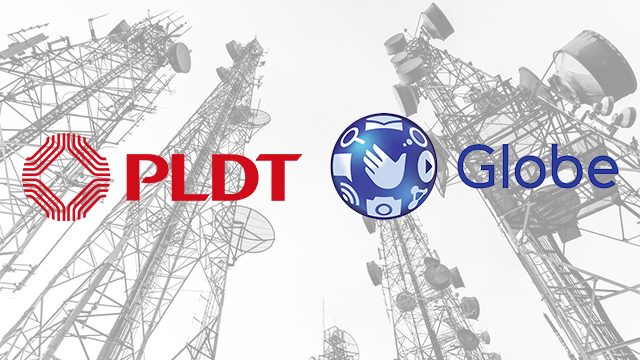SUMMARY
This is AI generated summarization, which may have errors. For context, always refer to the full article.

MANILA, Philippines (3rd UPDATE) – The country’s two telecommunication giants – Globe Telecom, Incorporated and Philippine Long Distance Telephone Company (PLDT) – activated their first cell sites using the 700 megahertz (MHz) spectrum they recently acquired from San Miguel Corporation (SMC).
“We just fired up the first 700 MHz over the weekend. It is located in UP Diliman, Quezon City. The test showed it is reaching distances that our frequencies could not reach,” Globe President and CEO Ernest Cu said in a Rappler interview.
Joel Agustin, Globe senior vice president for Program Governance, Network Technical Group, said the cell site will generate speeds of 60 Mbps to 100 Mbps.
PLDT chairman Manuel V. Pangilinan, meanwhile, posted these on Twitter late Tuesday, June 7:
3rd 700 MHz fired up and on air. Manggahan Pasig LTE 700 DL speed: 101.31 Mbps. Go Smart!
— Manny V. Pangilinan (@iamMVP) June 7, 2016
Our 2nd 700 MHz cell site up already! In Davao City at Ecoland, Matina. Download speed 101 Mbps. More to come.
— Manny V. Pangilinan (@iamMVP) June 7, 2016
This was after Pangilinan announced that same day that his telco set up its first 700 MHz base station in Tanay, Rizal. (READ: The future of 700 MHz band remains unclear)
Our first 700 MHz base station up tonight. At Tanay. More to come soon. #InternetEverywhere
— Manny V. Pangilinan (@iamMVP) June 6, 2016
The 3 cell sites fired up with 700 MHz are in Tanay, Rizal; Matina, Davao City; and Manggahan area in Pasig City, where peak download speeds of 101 Mbps were attained on a single-band, 700-MHz LTE set-up.
The two telcos’ moves come less than a week after they acquired for P69.1 billion the telecommunication business of SMC.
Globe’s Agustin said the National Telecommunications Commission (NTC) inspected the telco’s first 700 MHz cell site last Monday, June 6.
Globe to concentrate in NCR
Using Globe’s existing towers, Agustin said the company plans to “roll out initially about 200 sites using the 700 MHz frequency.” (READ: Telstra-San Miguel venture a bumpy, costly ride – think tank)
“The intention is that the first batch of the 200 sites we plan to roll out will be in areas where connectivity matters most to our customers as well as in locations with high convergence of users like here in the National Capital Region (NCR),” he said.
According to Cu, it is “boon for the country” that Globe and PLDT now have the right to use the 700 MHz because the two telcos can easily turn on new cell sites.
“Now, [in building cell sites], we just have to seek permission to set up antenna, which is a small hurdle compared to setting up a brand new tower,” Cu explained.
For Globe subscribers whose phones are not compatible with Long Term Evolution (LTE), Agustin said they will also benefit from the deployment of the 700 MHz cell sites through the decongestion of users on other frequencies.
The qualities of 700 MHz frequency make it the “most valuable frequency range for 4G/LTE technology,” Agustin said.
The Globe executive said the 700 MHz frequency will address bandwidth demand for multimedia content.
“About 70 to 80% of our customers are transacting data indoors and we need the 700 MHz spectrum to provide better coverage and stable connectivity inside their homes,” Agustin said.
He added that it will also allow Globe to improve coverage in rural areas. “[It will] allow our customers in those locations to gain internet access,” Agustin said.
PLDT to roll out in NCR, Davao, Cebu
For PLDT, its 700 MHz LTE cell sites will be activated in Metro Manila, Cebu, and Davao within the year.
“We plan to roll out 360 700 MHz LTE cell sites in Metro Manila, Cebu, and Davao this year,” PLDT Group spokesperson Ramon Isberto told Rappler.
PLDT and Smart chief technology and information advisor Joachim Horn earlier said the telco is talking with device manufacturers to offer more affordable LTE smartphones and tablets.
“We have been holding discussions with device manufacturers so that more affordable LTE smartphones and tablets using 700 MHz will soon be available in the country,” Horn said in a separate statement.
PLDT is also planning the next stage of LTE development called LTE-Advanced (LTE-A), also referred to as 4.5G, enabling speed of up to 250 Mbps.
Last April, Smart set up the country’s first 4.5G service in the resort island of Boracay, using a feature of LTE-A called carrier aggregation.
Under the terms of the deal, PLDT and Globe said they will be returning frequencies in the 700 MHz, 850 MHz, 2500 MHz, and 3500 MHz to NTC supposedly for the use of a 3rd telco.
But for some analysts, the deal means closing the door on a potential 3rd telecom player for the foreseeable future. While several analysts view it as a win for all 3 firms, they, along with the Philippine Competition Commission, are uncertain if it will ultimately benefit consumers. – Rappler.com
Globe Telecom is currently hiring. Click here to check out their vacancies and start your career in Globe today!
Add a comment
How does this make you feel?
There are no comments yet. Add your comment to start the conversation.